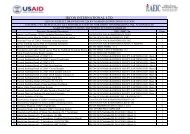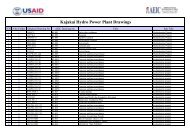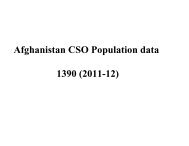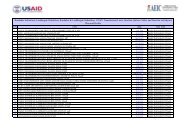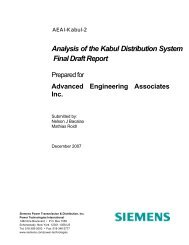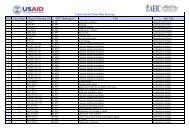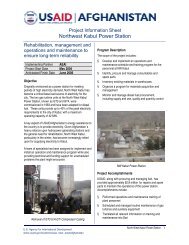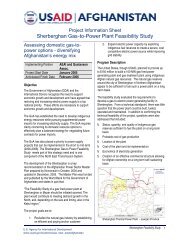prioritization and implementation plan - Cooperazione Italiana allo ...
prioritization and implementation plan - Cooperazione Italiana allo ...
prioritization and implementation plan - Cooperazione Italiana allo ...
You also want an ePaper? Increase the reach of your titles
YUMPU automatically turns print PDFs into web optimized ePapers that Google loves.
MEETING RESOURCE REQUIREMENTS AND MEASURING FOR RESULTS<br />
Budgets for each of the National Priority Programs<br />
are included in the Intended Results <strong>and</strong> Budget<br />
Matrices in this volume, as well as further<br />
elaborated in Volume II. Based on consultation<br />
with donors, the Government of Afghanistan<br />
estimates that approximately $10 billion will be<br />
available to support core socio-economic<br />
development initiatives over the coming three<br />
years, with additional resources available to<br />
support current governance <strong>and</strong> security sector<br />
strengthening priorities. The Government has<br />
stated its desire that the international community<br />
direct 80% of its total socio-economic<br />
development assistance in support of its fifteen<br />
socio-economic development National Priority<br />
Programs. In this regard, an overall budget ceiling<br />
of $8 billion was assigned, with the Agriculture<br />
<strong>and</strong> Rural Development Cluster accounting for<br />
around 26% of the total (US$2.8 billion), the<br />
Human Resource Development Cluster around<br />
25% (US$1.9 billion), <strong>and</strong> Economic <strong>and</strong><br />
Infrastructure Development Cluster around 49%<br />
(US$3.8 billion). These funds were judged to be<br />
incremental <strong>and</strong> could be added to existing highperforming<br />
programs with committed funds <strong>and</strong><br />
additional absorptive capacity. Draft budgets for<br />
the Economics <strong>and</strong> Social Development <strong>and</strong><br />
Governance Clusters National Priority Programs<br />
are outlined in the Intended Results <strong>and</strong> Budget<br />
Matrices in this volume, as well as further<br />
elaborated in Volume II. In addition, the projected<br />
budget for the Afghanistan Peace <strong>and</strong><br />
Reconciliation Program is nearly US$800 million.<br />
On the subject of monitoring <strong>and</strong> evaluation, even<br />
the best of <strong>plan</strong>s are ineffectual if their<br />
<strong>implementation</strong> cannot be tracked with technical<br />
rigor. A major weakness of ANDS monitoring <strong>and</strong><br />
evaluation efforts has been delays in defining a<br />
mechanism for monitoring <strong>and</strong> evaluation of the<br />
outcomes in sectors <strong>and</strong> ministry levels.<br />
Additionally, a lack of robust data systems has<br />
hampered effective monitoring.<br />
Through the introduction of cluster groupings of<br />
ministries <strong>and</strong> development of this ANDS<br />
Prioritization <strong>and</strong> Implementation Plan,<br />
46<br />
monitoring <strong>and</strong> evaluation is given renewed<br />
emphasis. Intended results – in the form of both<br />
outcomes <strong>and</strong> outputs – have been defined for all<br />
National Priority Programs individually, <strong>and</strong> in<br />
some cases for clusters as a whole. The total<br />
number of intended results has been kept<br />
manageable, <strong>and</strong> each are elaborated in easy-toreview<br />
matrices, <strong>allo</strong>wing for the monitoring of<br />
different program components that contribute to<br />
the achievement of specific program <strong>and</strong> cluster<br />
outcomes <strong>and</strong> outputs. Moreover, full program<br />
results frameworks will be prepared following<br />
detailed assessments, design, <strong>and</strong> costing of the<br />
new National Priority Programs, <strong>and</strong> these will be<br />
connected to the national budget process <strong>and</strong> the<br />
ANDS results-based management system, initiated<br />
one year ago (as introduced in the First Annual<br />
ANDS Report 2008/09) to inform decision-making.<br />
The Ministry of Economy is chiefly responsible for<br />
coordinating monitoring <strong>and</strong> evaluation, with the<br />
Central Statistics Organization responsible for data<br />
collection. While the Central Statistics Office will<br />
supply data, the Ministry of Economy will serve as<br />
the chief data-analyzer for generating monitoring<br />
reports <strong>and</strong> proposing corrective actions, with<br />
support from the Ministry of Finance.<br />
Data generation for monitoring will occur on two<br />
levels. The initial basic level involves the<br />
collection of data from responsible implementing<br />
ministries <strong>and</strong> agencies through their normal<br />
operations in support of program monitoring<br />
indicators. It draws on monthly progress reporting<br />
by all ministries <strong>and</strong> agencies employing<br />
st<strong>and</strong>ardized reporting formats. At the second<br />
level, the Central Statistics Organization will<br />
collect data directly through various channels,<br />
including multi-purpose household surveys (e.g.,<br />
the National Risk <strong>and</strong> Vulnerability Assessment),<br />
other surveys, st<strong>and</strong>ard reporting tools targeting<br />
various respondents, <strong>and</strong> an administrative<br />
statistical system. The Government will utilize the<br />
data to inform discussions <strong>and</strong> decision-making in<br />
the Cluster Coordination Committee, Cabinet, <strong>and</strong><br />
Joint Coordination <strong>and</strong> Monitoring Board <strong>and</strong> its<br />
various St<strong>and</strong>ing Committees <strong>and</strong> working groups.





